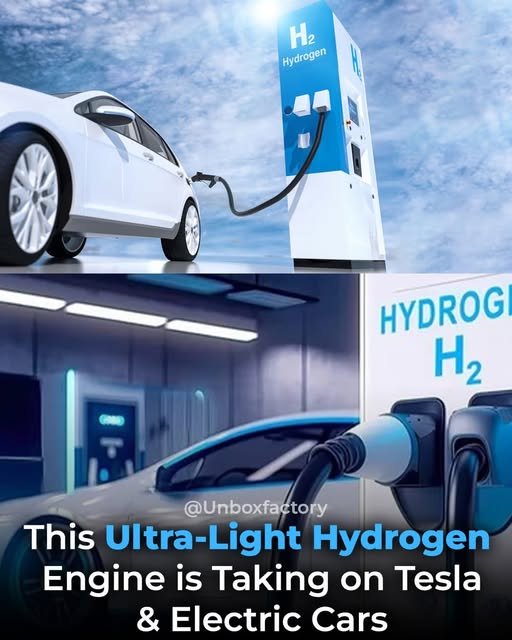Aquarius Engines has introduced a revolutionary 22-pound (10 kg) hydrogen engine that could reshape clean energy, transportation, and fossil fuel alternatives.
What Makes This Engine Special?
Ultra-Lightweight: Weighs just 22 lbs (10 kg), far lighter than conventional engines.
Minimal Components: Only 20 essential parts and one moving part, reducing cost and maintenance.
Zero Emissions: Runs on pure hydrogen combustion, eliminating the need for fuel cells.
Cost-Effective: A cheaper, highly efficient alternative to fuel cells and lithium-ion batteries.
Proven Tech: Successfully tested by AVL-Schrick, validating its hydrogen-only performance.
Hydrogen vs. EVs: The Clean Energy Battle Continues
Japan is heavily investing in hydrogen infrastructure.
Auto giants like Volkswagen and Tesla favor full electrification and battery technology.
Aquarius has partnered with major manufacturers like TPR and Musashi Seimitsu, showing hydrogen’s growing potential.
Beyond Cars: Future Applications
Power Generators: Originally designed for renewable energy production.
Aerospace Engineering: Potential for lightweight aircraft propulsion.
Decentralized Energy: A game-changer for off-grid and backup power.
With climate goals pushing for net-zero emissions, this next-gen hydrogen engine could drive a major shift in sustainable mobility and clean energy solutions.
Is hydrogen the future of clean transportation, or will EVs remain dominant?
The future of clean transportation is a complex, evolving landscape, and both hydrogen and electric vehicles (EVs) have significant roles to play. The ultimate outcome depends on various factors such as technology advancements, infrastructure development, market needs, and policy decisions. Let’s break down the case for each:
Hydrogen as the Future of Clean Transportation
Advantages of Hydrogen Fuel Cells
- Fast Refueling: Hydrogen vehicles can be refueled in just a few minutes, much like conventional gasoline-powered cars. This is a major advantage over EVs, which typically require longer charging times.
- Longer Range: Hydrogen fuel cells can offer longer driving ranges compared to current battery-electric vehicles, which may be crucial for heavy-duty transport (e.g., trucks, buses) and long-distance travel.
- Lower Weight for Heavy-Duty Applications: Hydrogen fuel cells are seen as a potentially better solution for large commercial vehicles, like trucks, trains, ships, and airplanes, because hydrogen tanks are lighter than large battery packs needed for long-range EVs.
- Energy Density: Hydrogen has a higher energy density by weight than batteries, which could make it more suitable for applications where weight and volume are significant concerns.
Challenges for Hydrogen
- Infrastructure: Hydrogen fueling stations are currently limited, and expanding the infrastructure is a huge challenge. Building a network of refueling stations requires significant investment and coordination.
- Production: Most hydrogen today is produced from natural gas (via steam methane reforming), which is not carbon-free. Green hydrogen, produced using renewable energy sources (like electrolysis), is more sustainable but is still expensive.
- Efficiency: The process of producing, storing, transporting, and converting hydrogen back into electricity (or using it directly) can be less efficient than directly charging batteries. Hydrogen fuel cell efficiency often falls short compared to the direct use of electricity in EVs.
- Cost: Fuel cells and hydrogen infrastructure are currently expensive. While costs are expected to drop, it will take time for the technology to become affordable on a large scale.
Electric Vehicles (EVs) as the Dominant Force
Advantages of EVs
- Growing Infrastructure: EV charging networks are rapidly expanding globally. Many regions are investing in widespread fast-charging stations, making EVs increasingly convenient for everyday use.
- Lower Operating Costs: EVs have fewer moving parts than internal combustion engine (ICE) vehicles, resulting in lower maintenance costs. Additionally, the cost of electricity is generally lower than gasoline or diesel, leading to cheaper operation.
- Battery Technology Advancements: With rapid advancements in battery technology, such as solid-state batteries and improvements in lithium-ion batteries, EVs are becoming cheaper, lighter, and offering longer ranges.
- Wide Adoption: EVs have already achieved significant market penetration in consumer vehicles, with major automakers investing heavily in EV production. EVs are becoming more affordable, and many governments offer incentives to support EV adoption.
- Energy Efficiency: EVs are highly energy-efficient. Electric motors are much more efficient than internal combustion engines, meaning that more of the energy from the battery is used to move the vehicle.
Challenges for EVs
- Charging Time: While fast-charging technology is improving, it still takes longer to charge an EV compared to refueling a hydrogen vehicle or a gasoline car. This can be an issue for long trips, though battery swapping (as seen in some countries) is being explored as a potential solution.
- Range Limitations: While EV ranges are improving, long-range EVs still tend to be more expensive, and for some applications (like heavy-duty trucking or long-haul flights), EVs may not yet provide the optimal solution.
- Battery Raw Materials: The production of EV batteries requires raw materials like lithium, cobalt, and nickel, some of which are in limited supply and require environmentally and ethically challenging mining practices. Supply chain disruptions could hinder EV growth if not managed properly.
- Environmental Impact of Manufacturing: While EVs produce zero tailpipe emissions, the environmental impact of manufacturing batteries (especially mining and processing of raw materials) remains a concern.
Which Will Dominate?
- For Personal Vehicles (Cars and Light Trucks): EVs are more likely to remain dominant in the near to medium term. The combination of lower costs, improved charging infrastructure, and stronger policy support in many countries makes EVs the clear frontrunner for consumer adoption.
- For Heavy-Duty and Long-Distance Transport: Hydrogen might play a larger role in sectors where EVs struggle. Hydrogen fuel cells could be more suitable for large commercial trucks, buses, ships, and even airplanes, where long refueling times and the weight of large battery packs become significant challenges. For these sectors, hydrogen could offer a compelling alternative to both traditional fossil fuels and battery-electric solutions.
Hybrid Solutions
It’s also possible that hydrogen and EVs will coexist in different niches of the transportation ecosystem. For example:
- Hydrogen for Freight: Hydrogen could dominate heavy-duty trucking, shipping, and air transport, where batteries are less practical due to weight and range limitations.
- EVs for Urban and Personal Mobility: EVs are likely to remain the dominant solution for personal cars and smaller vehicles, particularly in urban environments where charging infrastructure is robust.
Conclusion
While EVs will likely remain dominant in the personal transportation market due to advances in battery technology, infrastructure, and cost reductions, hydrogen has significant potential in specific areas, particularly in heavy-duty transport and long-distance applications. It’s plausible that the future of clean transportation will involve a mix of both technologies, with each playing to its strengths in different sectors of the economy.



